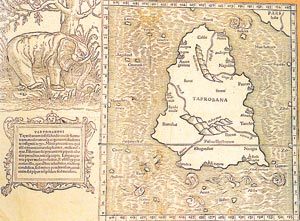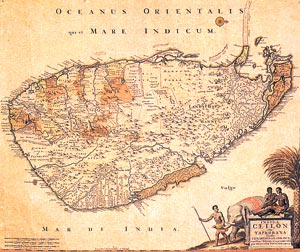It is 38 years since our country came to be officially named as Sri Lanka. Earlier, it was known as Ceylon in English and Lanka in Sinhala. On
May 22, 1972, the country was re-named Sri Lanka when it was declared a Free, Sovereign and Independent Republic.
Over the centuries our country has been known by different names. The change of the country's name from time to time is a fascinating story.
The earliest known name is 'Tambapanni' and it goes back to the arrival of Vijaya.
 |
| Ptolemy’s Map |
When the ship in which Vijaya and his men arrived having had a hostile
reception at an earlier place they landed, they grasped the earth with their hands which became red by contact with the soil.
They then named the place Tambapanni meaning copper-coloured hand. The name was extended to cover the district and later to the whole island.
There is reference in Greek literature around the fourth century B.C., to 'Taprobane' which obviously had derived from Tambapanni.
The earliest mention, according to
historian and archaeologist Professor Senerat Paranavitana, is found in the work of Onesicritus, the chief navigator on Alexander the Great's
voyage down the Indus (in India).
He had got the
information from the
sea-faring men of the Indus delta who had a long acquaintance with the Island since their ancestor had founded the first Aryan settlements there. At least three Greek writers had referred to the Island
giving accurate information about the duration of the sea journey from India, the shallow north-western seas, the stormy monsoon
weather, and the wealth of the Island in pearls, gems and elephants.
Indian emperor Asoka mentions Tambapanni in his inscriptions dating back to the 3rd century B.C., as outside the limits of his dominions.
'Taprobana' was how the Alexandrian geographer, Claudius Ptolemy identified the Island when he drafted his map of Sri Lanka. One of the earliest maps of
Sri Lanka, it carried an elaborately ornamented sketch of a wild elephant and a legend in Latin set inside a decorative frame. The map only had a vague resemblance to the Island's broad base and tapering tip.
 |
| Visscher’s Ceylon |
There is mention of the island in different names by different European powers which had trading ties with Sri Lanka. The Portuguese called it 'Ceilao', the Spanish referred to it as 'Ceilan' and the French
version was 'Selon'. To the Arabs it was 'Serendib'.
The Dutch, who occupied the country after the Portuguese, had used at least three versions – Zeilna, Ceilan and Seylon.
The first Dutch map drawn in the 17th century, carries a note referring to "once known to the
inhabitants as Taprobane, Tenarisin and Lankawn, most accurately mapped by Nikolaus Visscher". This is considered as one of the most accurate maps with topographical details.
The British introduced the English version 'Ceylon' to identify the country and showed keen interest in mapping and measuring their newly acquired
territory. In fact, the Survey Department was the first government department to be established – in 1800. Its task was to survey Crown land for diverse military, administrative and civilian purposes ranging from road and railway development to Crown land sales to
pioneering British coffee and tea planters.
As for names in Sinhala, the country has been called 'Lankadweepa' and 'Lakdiva' – both meaning the island of Lanka, and Lakbima.
Considering the shape of the island, it is often referred to as 'India's
tear drop' and 'Pearl of the Indian Ocean'.
Even after Independence in 1948, the country
continued to be called Ceylon for over six decades. In fact, tea continues to be branded as 'Ceylon tea' since the name is still popular. |



